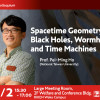Report of iTHEMS colloquium - Spacetime Geometry of Black Holes, Wormholes, and Time Machines
General relativity tells us how spacetime is curved by energy distribution and how matter moves in the spacetime. Classical black hole, which is a solution of the classical Einstein equation, has the event horizon and singularity. Event horizon, from which anything cannot escape, is defined at infinite future, and physical quantities such as energy density diverge at the singularity. These properties are not physically acceptable. Then, what are black holes in our universe? Prof. Pei-Ming Ho (National Taiwan University) addressed this question by studying quantum effects in general relativity. The key is the nature of the vacuum. Classical matter always has positive energy, but in quantum field theory the expectation value of energy density can be negative due to quantum fluctuation of the vacuum. The semi-classical Einstein equation connects the expectation value of energy-momentum tensor to the curvature of spacetime. If there is negative energy, traversable wormhole solutions can be constructed. They could be used as time machines for backward time travel, but they would lead to several paradoxes like “Grandfather paradox”. Prof. Ho explained this topic by showing how SF movies were inconsistent with physical laws. Then, he asked “What are the appropriate energy conditions to avoid inconsistencies?” The answer is still unknown, but it should be related to so-called “information paradox” in black holes. Suppose that a star (classical matter) collapses to a classical black hole. Hawking derived that the black hole evaporates slowly by emitting radiations due to the quantum properties of the vacuum. Then, where has the information of the matter gone after the evaporation? The information seems to disappear because the matter is trapped inside the horizon while the black hole evaporates. Any information must be preserved in quantum theory, but the mechanism is not clear in the black hole evaporation. As he said, one scenario is that some remnant is formed instead of complete evaporation. He first explained that, due to quantum fluctuation of the vacuum, the region near the would-be horizon is modified to obtain a “neck” structure without a horizon. The (proper) volume inside the neck is larger than the usual volume of the 3-dimensional sphere with the radius of the neck (because of negative energy). This is like a SF apartment: when you enter a room, it has a larger space than you expected from the outside. This is one possibility of quantum black holes. He also discussed dynamics of the neck black hole. As it evaporates, the neck would shrink and the information inside the neck would be left as a remnant, but this seems to be not a good solution to the information problem because the information would be isolated from the exterior world forever. Finally, he introduced his recent progress: when a trapping horizon (a local and dynamical notion of horizons) becomes timelike, negative energy occurs and the black-hole mass decreases (not by Hawking radiation). It is a non-perturbative effect w.r.t. Planck constant, which could not exist in the classical limit. This result implies that the four factors are closely related: dynamics near quantum black hole, appropriate energy condition including quantum effects, a more proper description beyond the semi-classical one, and the mechanism of information recovery. His entertaining talk showed that a black hole is not just a hole but a window to a new world. It is time to ask again “What is black hole?”


